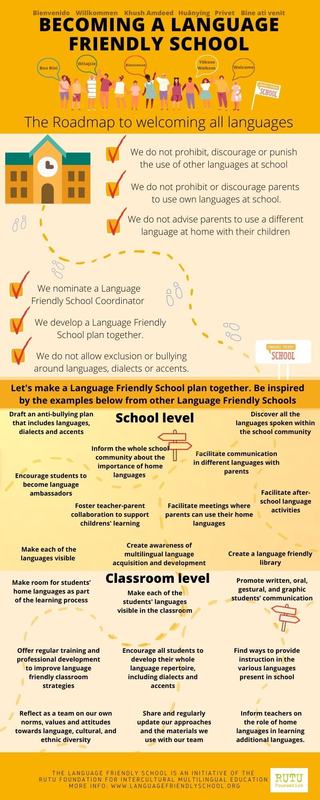Every year, February 21st marks International Mother Language Day. This day recognizes that languages and multilingualism can advance inclusion, and the Sustainable Development Goals’ focus on leaving no one behind. UNESCO believes education, based on the first language or mother tongue, must begin from the early years as early childhood care and education is the foundation of learning.
This article highlights the work of Language Friendly School, a selected innovator for the HundrED Spotlight on Bilingual Education in partnership with the Swedish Cultural Foundation, an answer to the increasing multilingualism present in schools across the world; a result of people migrating to other places seeking employment, reuniting with loved ones or escaping war and conflict. Within a Language Friendly School, everyone welcomes and values all languages spoken by the students, the parents and the school stakeholders. Join us in our mission and let’s make the world a language friendlier place: one school at a time.
Why Language Friendly Schools?
Language is not and has never been a neutral instrument of communication. In fact, the languages we use are coloured by our social practices, and the way we speak them reveals many aspects of our ever-changing identities. Teachers often believe that the school language is a neutral language because it is the language they grew up with and were trained in. Moreover, a certain set of tenacious beliefs in the teaching world has long prevented the embrace of languages spoken by the students.
The first is that exposure alone to the school language school would guarantee a sufficient level of academic language needed to do well in school; the second set of beliefs is that interference with other languages would constitute a marker of imperfection and the third, that the parasitic languages should be removed as soon as these imperfections surface. How many parents were told that they should speak the language of the school with their children?
Children whose languages are not spoken at school are thus torn between two worlds, that of the language(s) spoken outside the school and that of the language(s) admitted to the school in predefined and exclusive spaces. How many of these students have been told that they have an accent, pretty or ugly? Followed by the question where they - really - come from. The effect of such comments is always the same: children understand that they do not belong to the local school community.
Should schools continue to be language graveyards?
For many years, experts have been fighting around the world for the recognition of heritage languages in education. There are several reasons for this:
1. As Professor Cummins pointed out, the school has all too often become a graveyard of languages. This was recognized by the director of one of the Language Friendly Schools, the Silver Creek School in Toronto when he said:
“I went into school with two languages and I left with one. This is the exact opposite of what education should do; it should add things not take away things.”
2. It was discovered that the quality of language teaching is very important in learning and that learning is better and faster when it is based on the students' knowledge.
3. Longitudinal studies found that simultaneous teaching in the language of the school and in the mother tongues was the model that yielded the best results.
Nowadays, classrooms have students from different parts of the world and the number of languages in our classes far exceeds what even a polyglot teacher could manage. We simply cannot teach all languages!
The Language Friendly School welcomes all languages
This is where the Language Friendly School comes in: the aim of this global network and label is certainly not to teach all languages, but to welcome all languages. The first thing we learn in a Language Friendly School is not to apply fixed linguistic and cultural identities to students. Diversity is taught by living and celebrating it.
Welcoming and valuing all languages spoken in the school is the primary aim of the Language Friendly School programme. The way schools do this, however, is left to each individual school. This is because every school is different, with widely varying languages, student and teacher populations, and operating in vastly different education systems. Therefore, a one-size-fits-all model does not work. However, schools that join the network are asked to systematically make an inventory of the languages that are present. Teachers interview parents, children, and members of the school community. Schools are also encouraged to make their languages visible in the school space. Giving a place to the writing of these languages might also be important: the students feel recognized, welcomed, and therefore encouraged to learn more and better.
The Language Friendly School Roadmap
The Language Friendly School offers schools an inspirational menu of strategies embedded in a Language Friendly School Roadmap

In the classroom, teachers build on prior knowledge and experiences of children that have often been gained through their mother tongues. For example, students doing homework assignments that involve knowledge accumulated in the family context helps them to build new knowledge within their own world. This language-friendly strategy helps to avoid underestimating students' abilities in relation to their level in the school language and to maintain high expectations for each of them.
At the school level, reception of the mother tongue has a significant social and inclusive function: in a school like Silver Creek, a student who speaks Spanish or Arabic, for example, may be asked to become a language ambassador: welcoming newly arrived students and their parents in their language and showing them around the school. In this way, the student’s knowledge is recognized, respected, encouraged, and celebrated.
Learn more about Language Friendly School at: https://hundred.org/en/innovations/language-friendly-school#9f85e48c
[Cover Picture: at the Silver Creek School, Language Ambassadors welcome new students and also organize Word of the Month-activities. Photo: Silver Creek School]




